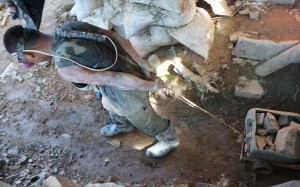Program takes child laborers back to school
MANILA, Philippines—Since she was 6, Jeraldine “Pitang” Macapaar Aboy has been braving the poisonous snakes and beating the heat from burning sugarcane as a young plantation worker in Bukidnon.
But Aboy, who has always worked with her father, had to go it alone after he was diagnosed with kidney disease.
“My father got sick so we asked the plantation owner if we could go home. We were told that someone should replace him first. I had to replace him,” Aboy recounted in a forum on Thursday on “Ending the Worst Forms of Child Labor in the Philippines.”
“I was only 8 years old when I took the place of my father in the plantation,” said Aboy, the second of five children, struggling to hold back her tears.
Aboy, now 14, and over a hundred other child laborers, went back to school last year through “Bata Balik-Eskwela,” a project implemented by the Ecumenical Institute for Labor Education and Research Inc. (Eiler) and funded by the European Union.
Out of danger
“Through the reintegration of child laborers back to school, the children are in a way saved from risking life and limb to do hazardous work out in the fields and inside mining tunnels,” Eiler executive director Anna Leah Escresa-Colina said.
Two out of every 10 households tolerate child labor in mines and plantations, according to a survey conducted by Eiler and Quidan Kaisahan from April to October 2014 in the places where they implement the project.
The study showed the “worsening working conditions” of child laborers in Bukidnon, Camarines Norte, Compostela Valley, Agusan del Sur, Davao del Norte and Negros Occidental.
Children use illegal drugs to keep them awake while working for 16 hours inside tunnels of Mt. Diwata, Monkayo in Compostela Valley, Colina said.
The illegal drugs even come from employers, she added.
Child laborers are influenced by their adult coworkers to engage in vices such as gambling, drinking and smoking, she said.
“Work available to children is often dangerous and hazardous to their health, which is worsened by the lack of any personal protective gear. They are exposed to chemicals or use of heavy equipment without any proper training on their use,” she said.
For Aboy, the most difficult part of his job was burning sugarcane because of the heat, she told the Inquirer in an interview, adding that she also gathers them and loads them in trucks. She worked from 4 a.m. to 7 p.m.
Being bitten by venomous snakes was also a danger she had to face.
“I am very afraid of snakes. I have witnessed how my fellow child laborer was bitten by a snake while we were clearing off grasses in the plantation,” she said.
When she was badly wounded, the plantation owner did not give her medical attention.
“My uncle (who was then 16 years old) resorted to herbal medicines to ease my discomfort and I came back to work even if my wound was still bleeding,” Aboy said.
But despite all these, she only received P120 per day, which was not enough for her father’s medication, let alone food.
Colina said that in mining areas, one-half of the child laborers have a daily wage of below P100 while in plantations, 57 percent get P130 to 150 per day.
RELATED STORY
Where have all the children gone?















